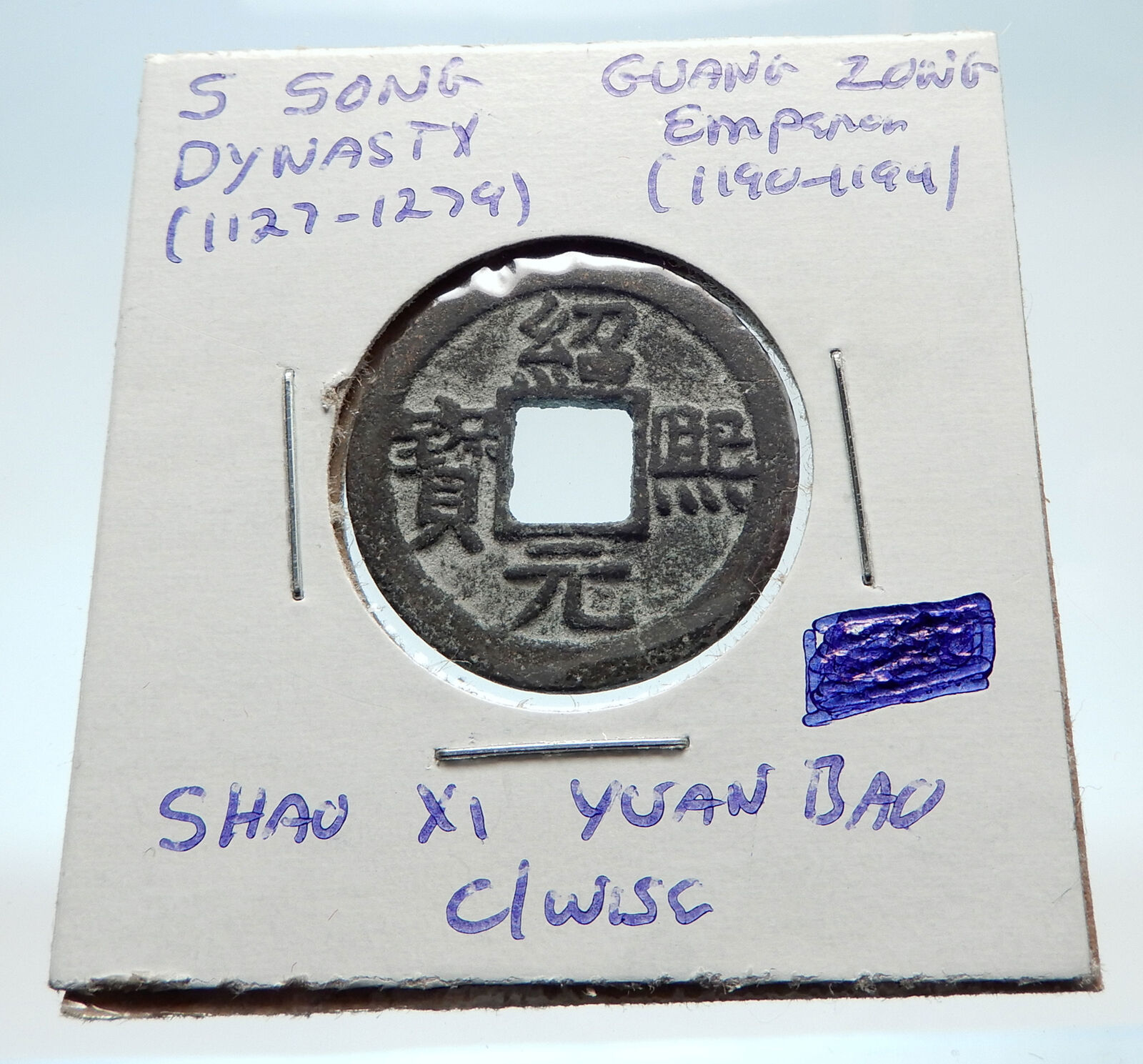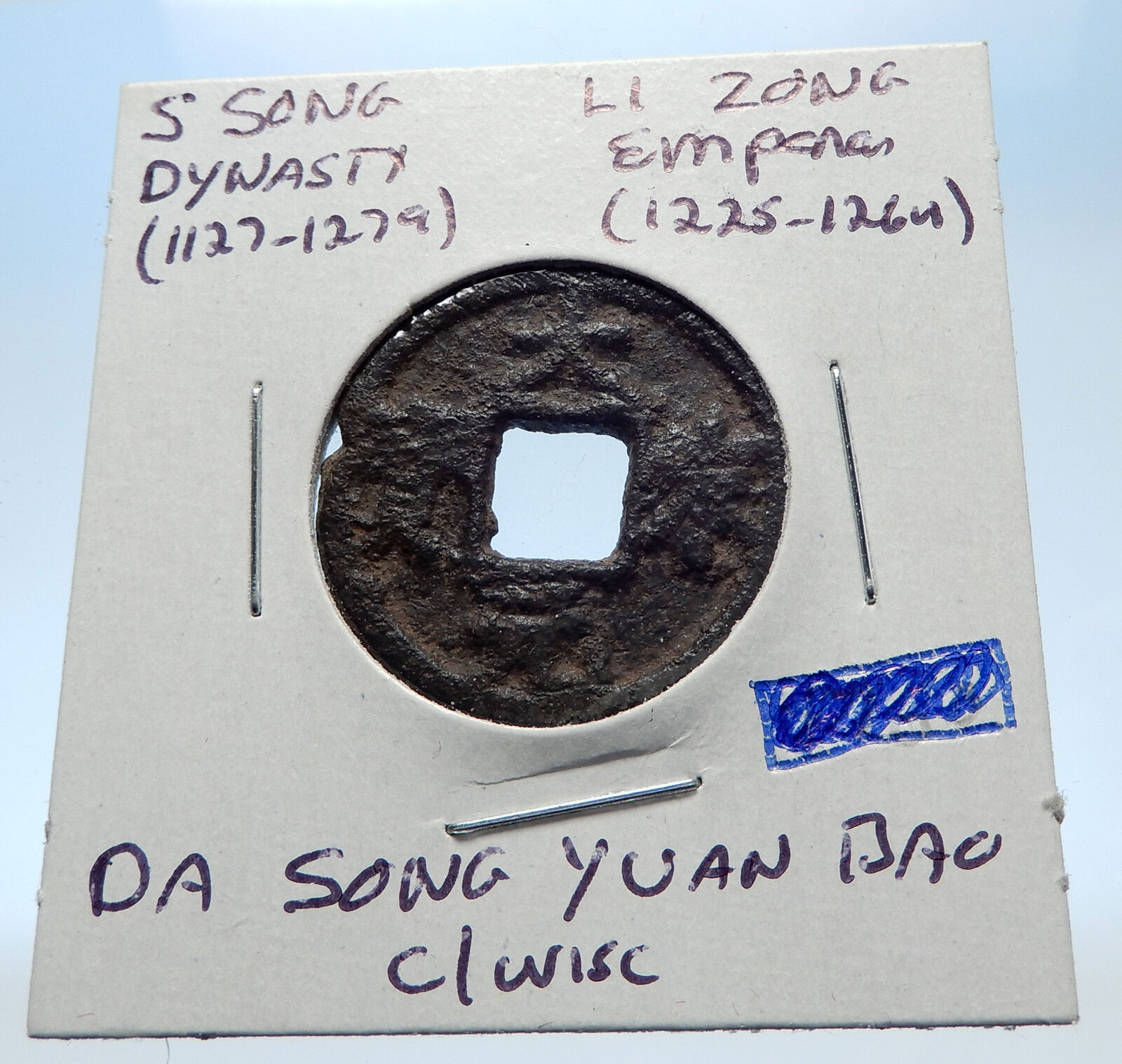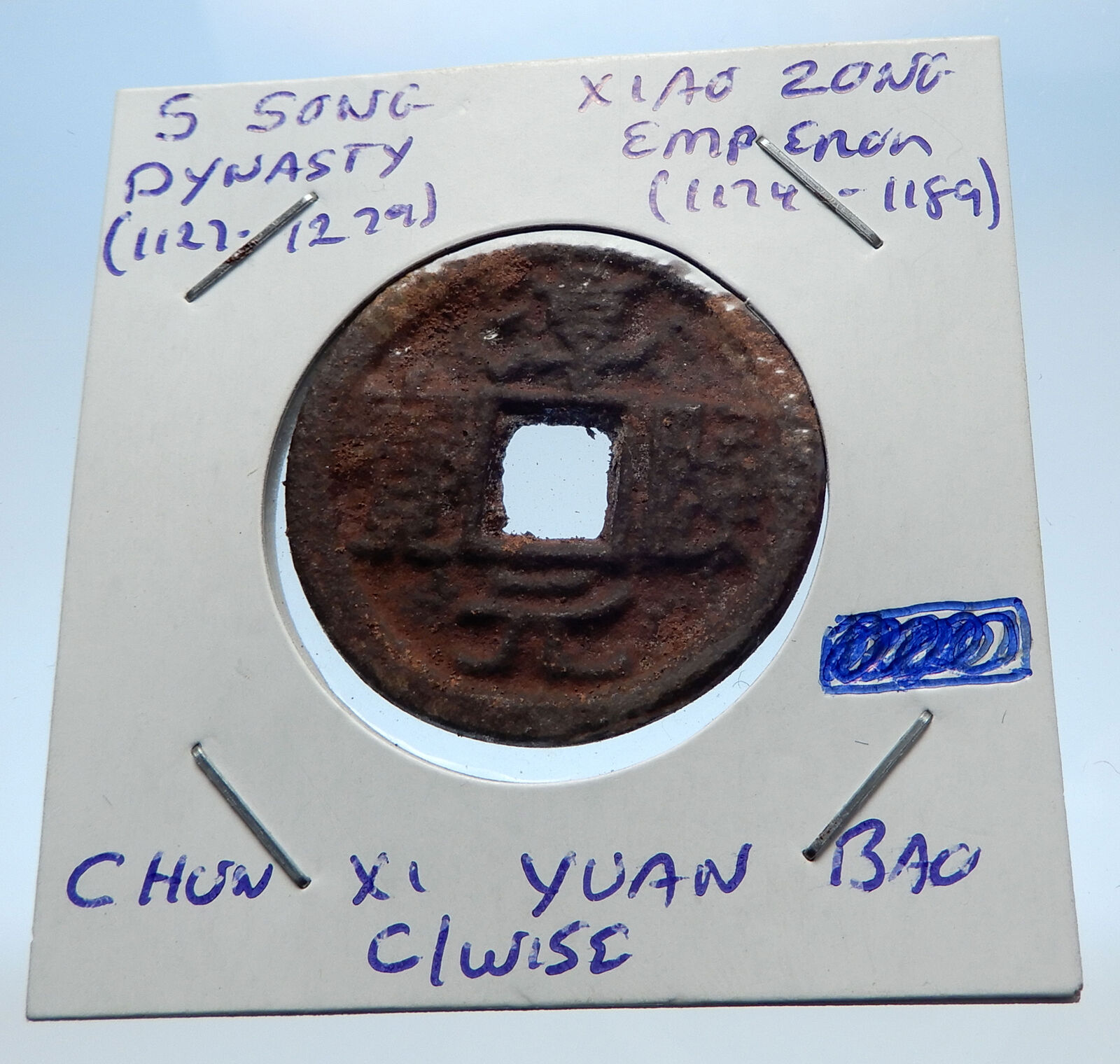|
China – Ten Kingdoms – Southern Tang (937-975 AD)
Emperor Yuan Zu (Li Jing) 943-961 AD
Bronze Bao Da Yuan Bao Cash Token 30mm (10.89 grams), Struck 943-957 AD
Reference: H# 15.77 (Bronze Example)
Chinese Symbols.
Tian above.
Coin Notes:
Most examples of this coin are made of Iron. This is an extremely rare bronze example of this coin (see reference.)
You are bidding on the exact item pictured, provided with a Certificate of Authenticity and Lifetime Guarantee of Authenticity.
 Li Jing (Chinese: 李璟, later changed to 李景; 916[1] – August 12, 961[2][3]), originally Xu Jingtong (徐景通), briefly Xu Jing (徐璟) in 937–939, courtesy name Boyu (伯玉), also known by his temple name Yuanzong (元宗), was the second ruler (sometimes called Zhongzhu, 中主, lit. ’Middle Ruler’) of imperial China’s Southern Tang state during the Five Dynasties and Ten Kingdoms period. He reigned his state from 943 until his death. Li Jing (Chinese: 李璟, later changed to 李景; 916[1] – August 12, 961[2][3]), originally Xu Jingtong (徐景通), briefly Xu Jing (徐璟) in 937–939, courtesy name Boyu (伯玉), also known by his temple name Yuanzong (元宗), was the second ruler (sometimes called Zhongzhu, 中主, lit. ’Middle Ruler’) of imperial China’s Southern Tang state during the Five Dynasties and Ten Kingdoms period. He reigned his state from 943 until his death.
During Li Jing’s earlier reign, he expanded Southern Tang’s borders by extinguishing smaller neighboring states: Min in 945 and Chu in 951. However, the warfare also exhausted the wealth of the country, leaving it ill-prepared to resist the Later Zhou invasion in 956. Forced to cede all prefectures north of the Yangtze River, he also had to relinquish his title as an emperor and accept Later Zhou’s overlordship in 958, and later Song Dynasty’s overlordship after 960 when Song succeeded Later Zhou.
 Ten Kingdoms: Unlike the dynasties of northern China, which succeeded one another in rapid succession, the regimes of South China were generally concurrent, each controlling a specific geographical area. These were known as “The Ten Kingdoms” (in fact, some claimed the title of Emperor, such as Former Shu and Later Shu). Each court was a center of artistic excellence. The period is noted for the vitality of its poetry and for its economic prosperity. Commerce grew so quickly that there was a shortage of metallic currency. This was partly addressed by the creation of bank drafts, or “flying money” (feiqian), as well as by certificates of deposit. Wood block printing became common during this period, 500 years before Johannes Gutenberg’s press. Ten Kingdoms: Unlike the dynasties of northern China, which succeeded one another in rapid succession, the regimes of South China were generally concurrent, each controlling a specific geographical area. These were known as “The Ten Kingdoms” (in fact, some claimed the title of Emperor, such as Former Shu and Later Shu). Each court was a center of artistic excellence. The period is noted for the vitality of its poetry and for its economic prosperity. Commerce grew so quickly that there was a shortage of metallic currency. This was partly addressed by the creation of bank drafts, or “flying money” (feiqian), as well as by certificates of deposit. Wood block printing became common during this period, 500 years before Johannes Gutenberg’s press.
The Ten Kingdoms were:
- Yang Wu (907–937)
- Wuyue (907–978)
- Min (909–945)
- Ma Chu (907–951)
- Southern Han (917–971)
- Former Shu (907–925)
- Later Shu (934–965)
- Jingnan (924–963)
- Southern Tang (937–976)
- Northern Han (951–979)
Only ten are traditionally listed, hence the era’s name. Some historians, such as Bo Yang, count eleven, including Yan and Qi but not the Northern Han, viewing it as simply a continuation of Later Han. This era also coincided with the founding of the Liao dynasty in the north, and the Dali Kingdom in the southwest.
Other regimes during this period include Zhao, Yiwu Jiedushi, Dingnan Jiedushi, Wuping Jiedushi, Qingyuan Jiedushi, Yin, Ganzhou Uyghur Kingdom, Guiyi Circuit, and Xiliangfu.
Cash was a type of coin of China and East Asia, used from the 4th century BC until the 20th century AD. Originally cast during the Warring States period, these coins continued to be used for the entirety of Imperial China as well as under Mongol, and Manchu rule. The last Chinese cash coins were cast in the first year of the Republic of China. Generally most cash coins were made from copper or bronze alloys, with iron, lead, and zinc coins occasionally used less often throughout Chinese history. Rare silver and gold cash coins were also produced. During most of their production, cash coins were cast but, during the late Qing dynasty, machine-struck cash coins began to be made. As the cash coins produced over Chinese history were similar, thousand year old cash coins produced during the Northern Song dynasty continued to circulate as valid currency well into the early twentieth century.
In the modern era, these coins are considered to be Chinese “good luck coins”; they are hung on strings and round the necks of children, or over the beds of sick people. They hold a place in various superstitions, as well as Traditional Chinese medicine, and Feng shui. Currencies based on the Chinese cash coins include the Japanese mon, Korean mun, Ryukyuan mon, and Vietnamese văn.
|





 Li Jing (Chinese: 李璟, later changed to 李景; 916[1] – August 12, 961[2][3]), originally Xu Jingtong (徐景通), briefly Xu Jing (徐璟) in 937–939, courtesy name Boyu (伯玉), also known by his temple name Yuanzong (元宗), was the second ruler (sometimes called Zhongzhu, 中主, lit. ’Middle Ruler’) of imperial China’s Southern Tang state during the Five Dynasties and Ten Kingdoms period. He reigned his state from 943 until his death.
Li Jing (Chinese: 李璟, later changed to 李景; 916[1] – August 12, 961[2][3]), originally Xu Jingtong (徐景通), briefly Xu Jing (徐璟) in 937–939, courtesy name Boyu (伯玉), also known by his temple name Yuanzong (元宗), was the second ruler (sometimes called Zhongzhu, 中主, lit. ’Middle Ruler’) of imperial China’s Southern Tang state during the Five Dynasties and Ten Kingdoms period. He reigned his state from 943 until his death. Ten Kingdoms: Unlike the dynasties of northern China, which succeeded one another in rapid succession, the regimes of South China were generally concurrent, each controlling a specific geographical area. These were known as “The Ten Kingdoms” (in fact, some claimed the title of Emperor, such as Former Shu and Later Shu). Each court was a center of artistic excellence. The period is noted for the vitality of its poetry and for its economic prosperity. Commerce grew so quickly that there was a shortage of metallic currency. This was partly addressed by the creation of bank drafts, or “flying money” (feiqian), as well as by certificates of deposit. Wood block printing became common during this period, 500 years before Johannes Gutenberg’s press.
Ten Kingdoms: Unlike the dynasties of northern China, which succeeded one another in rapid succession, the regimes of South China were generally concurrent, each controlling a specific geographical area. These were known as “The Ten Kingdoms” (in fact, some claimed the title of Emperor, such as Former Shu and Later Shu). Each court was a center of artistic excellence. The period is noted for the vitality of its poetry and for its economic prosperity. Commerce grew so quickly that there was a shortage of metallic currency. This was partly addressed by the creation of bank drafts, or “flying money” (feiqian), as well as by certificates of deposit. Wood block printing became common during this period, 500 years before Johannes Gutenberg’s press.




